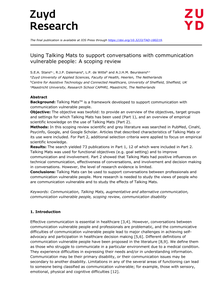From the introduction: "There are two variants of fronto-temporal dementia: a behavioral variant (behavioral FTD, bvFTD, Neary et al. (1998)), which causes changes in behavior and personality but leaves syntax, phonology and semantics relatively intact, and a variant that causes impairments in the language processing system (Primary Progessive Aphasia, PPA (Gorno-Tempini et al., 2004). PPA can be subdivided into subtypes fluent (fluent but empty speech, comprehension of word meaning is affected / `semantic dementia') and non-fluent (agrammatism, hesitant or labored speech, word finding problems). Some identify logopenic aphasia as a FTD-variant: fluent aphasia with anomia but intact object recognition and underlying word meaning."
MULTIFILE

Analysis of spontaneous speech is an important tool for clinical linguists to diagnose various types of neurodegenerative disease that affect the language processing areas. Prosody, fluency and voice quality may be affected in individuals with Parkinson's disease (PD, degradation of voice quality, unstable pitch), Alzheimer's disease (AD, monotonic pitch), and the non-fluent type of Primary Progressive Aphasia (PPA-NF, hesitant, non-fluent speech). In this study, the performance of a SVM classifier is evaluated that is trained on acoustic features only. The goal is to distinguish different types of brain damage based on recorded speech. Results show that the classifier can distinguish some dementia types (PPA-NF, AD), but not others (PD).
DOCUMENT
Background: Talking Mats is a framework developed to support communication with communication vulnerable people. Objective: The objective was twofold: to provide an overview of the objectives, target groups and settings for which Talking Mats has been used (Part 1), and an overview of empirical scientific knowledge on the use of Talking Mats (Part 2). Methods: In this scoping review scientific and grey literature was searched in PubMed, Cinahl, Psycinfo, Google, and Google Scholar. Articles that described characteristics of Talking Mats or its use were included. For Part 2, additional selection criteria were applied to focus on empirical scientific knowledge. Results: The search yielded 73 publications in Part 1, 12 of which were included in Part 2. Talking Mats was used for functional objectives (e.g. goal setting) and to improve communication and involvement. Part 2 showed that Talking Mats had positive influences on technical communication, effectiveness of conversations, and involvement and decision making in conversations. However, the level of research evidence is limited. Conclusions: Talking Mats can be used to support conversations between professionals and communication vulnerable people. More research is needed to study the views of people who are communication vulnerable and to study the effects of Talking Mats.
DOCUMENT
